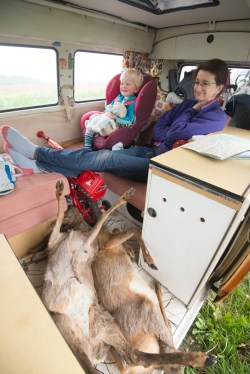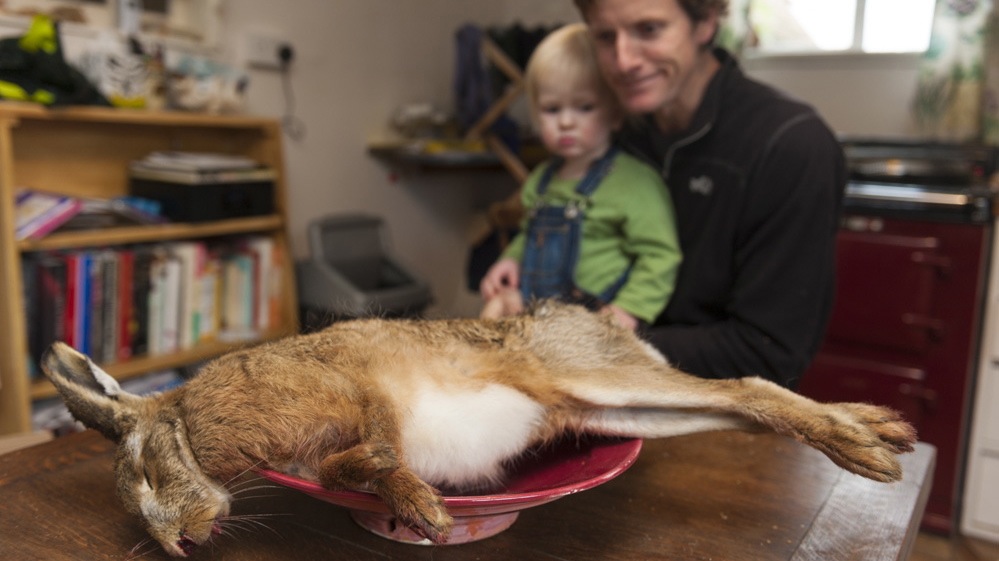Ian Cummings was cycling just outside Cambridge, England, when he noticed the freshly hit rabbit on the side of the road. “I sort of looked at it and looked at it, and then cycled on,” he says. But then, Cummings had a change of heart. He turned his bike around, brought the dead animal home, and cooked it into jugged hare — a traditional British recipe. “And it all kind of started from there.”
Since that first day when Cummings, a travel photographer based in the village of Wilbraham, wound up with a Goodyear-tenderized hare on his plate, he has gone on to become somewhat of a road-kill aficionado. From venison with cranberries and chestnuts to pappardelle con lepre, over the years his town’s roads have served him up some pretty delectable fares. But Cummings isn’t the only one out foraging the highways. There are plenty of road-kill enthusiasts on this side of the pond, too — enough of them that there has been a trend toward states legalizing the practice, like when Montana made headlines by doing so last year. And now, a push to make road kill easier to take home is on the docket in Michigan.

Ian CummingsCummings may be excited about cooking up some roadside deer, but his wife seems less enthused.
Still, road-kill cuisine isn’t everyone’s cup of tea. Cummings’ friend Austin Hunt, a doctor who lives in Derriford, England, got some flak after he wrote about the wonders of eating road kill in the The Telegraph; he and others who have spoken up for the practice in the past declined to comment for Grist because of past experiences in which they felt they had been sensationalized.
“Road kill” does bring plenty of grisly images to mind — from splattered asphalt to bumpers decorated with entrails. But is our revulsion, at least in part, tied to the fact that most of us don’t think about our meat until it’s fork-ready? There will be blood, guts, and marbled bits of fat, whether they come out on a butchering block or your Honda.
Some argue that salvaging road kill is actually the most ethical and environmentally responsible way to eat meat: It’s a way to maintain carnivorous habits while still opting out of highly questionable conventional means. “The meat industry is pretty extraordinary, particularly things like red meat. It takes something like 27 kilos of CO2 to produce each kilo [of beef],” Cummings says. “I think most people think about [the environmental impact of] jumping in their car, but they might not consider the environmental disaster of beef.”
Alright, but is it safe? Jackson Landers, an environmentally minded hunter who has also dined on some roadside victuals in his day, says the answer to that question comes down to temperature and time. “The digestive system is full of bacteria, which are normally held in check by the animal’s immune system,” Landers says. Once the animal dies, he says, there’s nothing to hold that bacteria back anymore, and the longer the animal has been out, and the warmer that it is outside, the more that bacteria will take over.
“My rule now is basically if I have to finish it off myself, it’s OK. I put a rifle in the trunk pretty much all the time when I’m in Virginia. And I would say it’s anywhere from three to half a dozen times a year that I will have to put an animal down on the side of the road where somebody else had hit it.”
Cummings is a little more lax about what he’ll collect: “Sometimes when I pick something up I do give the cat a little bit first, just in case for some reason, you know, something has happened,” he says. “Maybe slightly Russian roulette with [the cat], but he gets a good load of nice red meat that he doesn’t get otherwise.”
Ultimately, Landers says it all comes down to experience — and that most of the questions about it being an unsafe practice come from people who don’t have that background. “The nose doesn’t lie,” he says. “If there’s something wrong with the meat, you’re going to be able to tell.”
All in all, while Cummings still usually finds it a difficult subject to broach (fearing responses like, “The meal you invited us over for came from where?!”), he says the reactions that he’s gotten have been surprisingly positive, especially amongst those who are already inclined to think about the source of their food. “A lot of vegetarian friends have been like, ‘That’s really great to hear, and I really admire you for doing that,’” he says. (They also have a rather convenient excuse to not partake in a Cummings family dinner, though.)
While Landers says there’s not enough road kill to go around and shake up the meat industry, there is enough for people here and there to occasionally enjoy a feast of salvaged chow. Though, as laws change and the word gets out, that might not always be the case.
About a year and a half ago, Cummings’ wife excitedly burst through their door. “Quick, get the knife!” she exclaimed. There was a dying muntjac deer a mile down the road. “So I went there, and there was this rather sheepish looking guy standing over the deer with a pair of kitchen scissors in his hands,” Cummings recalls.
“What are you going to do with that?” Cummings asked. “I’m going to eat it, they’re rather tasty,” the challenger replied. Cummings had lost. “I’m glad you’re a man after my own heart,” the man said. Plunging the scissors through flesh, the man expertly dispatched of his four-legged find: dinner.




